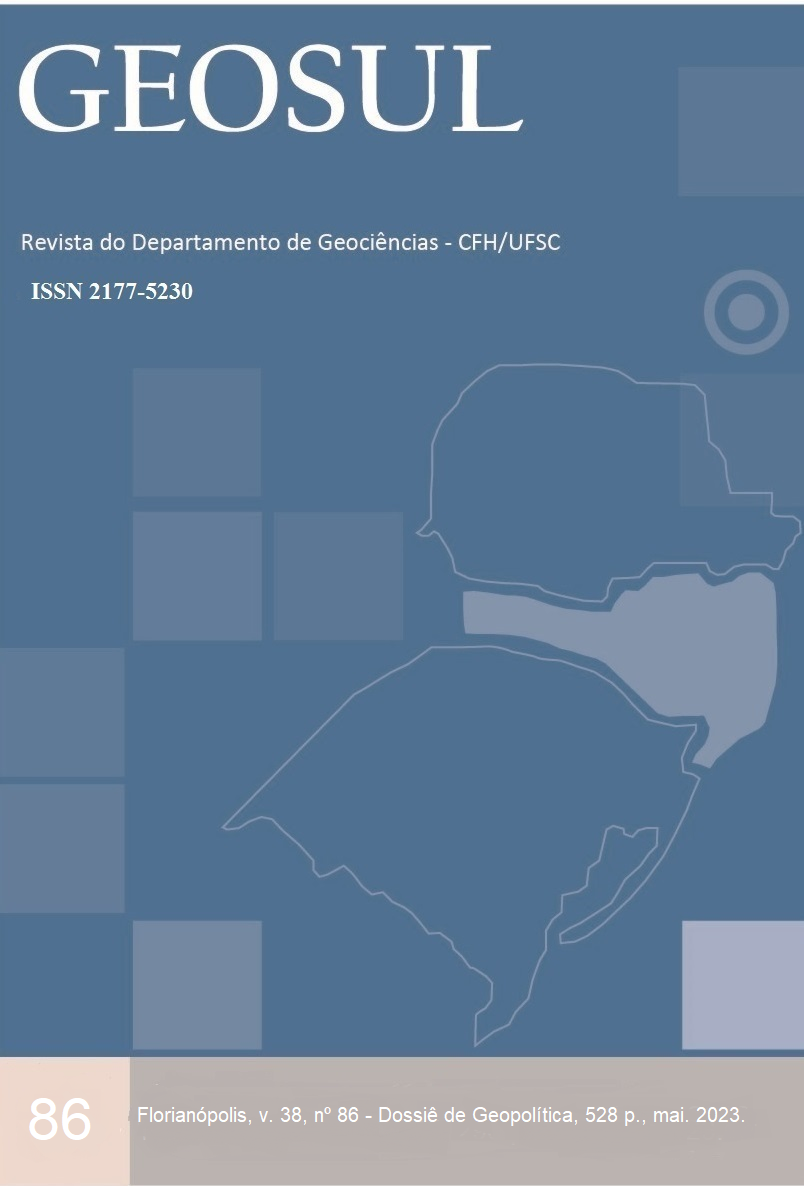A ASEAN e os desafios geopolíticos no Indo-Pacífico
DOI:
https://doi.org/10.5007/2177-5230.2023.e89896Palavras-chave:
Geopolítica, ASEAN, Sudeste Asiático, Indo-Pacífico, Rivalidade China-Estados UnidosResumo
Este artigo analisa os desafios geopolíticos com que se defrontam os países da ASEAN (Associação das Nações do Sudeste Asiático) e as pressões exercidas sobre seu papel na estabilidade, coesão e centralidade na arquitetura de segurança da região. Embora ao longo da história a ASEAN tenha se mostrado fundamental para a redução de conflitos em seu espaço geográfico, as transformações geopolíticas recentes em escala regional e global vêm alterando sobremaneira sua capacidade de gerir as incertezas e as adversidades, colocando em xeque a relevância da instituição na preservação da paz e da segurança na região do Indo-Pacífico, com a ascensão da China e sua crescente rivalidade com os Estados Unidos e as atribulações no Mar do Sul da China.
Referências
ACHARYA, A. The making of Southeast Asia: International relations of a region. Cornell University Press, 2013.
AGNEW, J. Geopolitics: Re-visioning world politics. Routledge, 2003.
ASEAN. Treaty of Amity and Cooperation in Southeast Asia. 1976. Disponível em: https://asean.org/our-communities/asean-political-security-community/outward-looking-community/treaty-of-amity-and-cooperation-in-southeast-asia-tac. Acesso em: 18 abr. 2022.
ASEAN. ASEAN Key Figures 2021. Jakarta, ASEAN Secretariat, December 2021.
BA, A. China and ASEAN: Renavigating relations for a 21st-centuryAsia. Asian Survey, v. 43, n. 4, p. 622-647, 2003.
BA, A. Southeast Asia in an age of strategic uncertainty: Legal rulings, domestic impulses, and the ongoing pursuit of autonomy. Southeast Asian Affairs, p. 3-18, 2017.
COOK, M. Hedging Harder: Southeast Asia and the US-China Rivalry. The ASAN Forum. 21 Dez. 2018. Disponível em: https://theasanforum.org/hedging-harder-southeast-asia-and-the-us-china-rivalry/#4. Acesso em: 22 Mai. 2022.
COSTA, W. M. O reerguimento da Rússia, os EUA/OTAN e a crise da Ucrânia: a Geopolítica da nova Ordem Mundial. Confins. Revue franco-brésilienne de géographie/Revista franco-brasilera de geografia, n. 25, 2015.
EMMERS, R. Unpacking ASEAN neutrality: The quest for autonomy and impartiality in Southeast Asia. Contemporary Southeast Asia, v. 40, n. 3, p. 349-370, 2018.
EUA. National Security Strategy of the United States of America. Executive Office of The President. Washington DC, 2017.
EUA. The administration’s approach to the People’s Republic of China. Antony J. Blinken Speech. 26.05.2022a. Disponível em: https://www.state.gov/the-administrations-approach-to-the-peoples-republic-of-china. Acesso em: 27 mai. 2022.
EUA. Fact Sheet: President Biden and G7 leaders launch Build Back Better World (B3W) Partnership. 06 Dez. 2021. Disponível em: https://www.whitehouse.gov/briefing-room/statements-releases/2021/06/12/fact-sheet-president-biden-and-g7-leaders-launch-build-back-better-world-b3w-partnership. Acesso em: 28 mai. 2022.
EUA. Indo-Pacific Strategy of the United States. Washington: The White House. Fev. 2022b. Disponível em: https://www.whitehouse.gov/wp-content/uploads/2022/02/U.S.-Indo-Pacific-Strategy.pdf. Acesso em 01 Jun. 2022.
GHIASY, R.; SU, F.; SAALMAN, L. The 21 Century Maritime Silk Road: Security implications and ways forward for the European Union. SIPRI/Friedrich Ebert Stiftung, 2018.
GOH, E. Southeast Asian perspectives on the China challenge. Journal of Strategic Studies, v. 30, n. 4-5, p. 809-832, 2007.
HAYTON, B. The South China Sea: The Struggle for Power in Asia. Yale University Press, 2014.
KAPLAN, R. Asia's cauldron: The South China Sea and the end of a stable Pacific. Random House, 2015.
KELLY, P. The Present Transition in Global Politics: Bipolarity or Multipolarity? World Affairs: The Journal of International Issues, v. 24, n. 1, pp. 10–23, 2020.
KISSINGER, H. Sobre a China. Editora Objetiva, 2011.
KUMAR, P. “U.S. should invite China to IPEF if it is sincere, Mahathir says”. Nikkei Asia. 27 mai. 2022. Disponível em: https://asia.nikkei.com/Spotlight/The-Future-of-Asia/The-Future-of-Asia-2022/U.S.-should-invite-China-to-IPEF-if-it-is-sincere-Mahathir-says. Acesso em 01 jun. 2022.
MACKINDER, H. J. O pivô geográfico da história. GEOUSP Espaço e Tempo (Online), v. 15, n. 1, p. 88-100, 2011. Disponível em: https://www.revistas.usp.br/geousp/article/view/74189. Acesso em: 19 maio. 2022.
MAHBUBANI, K.; SNG, J. The ASEAN miracle: A catalyst for peace. NUS Press, 2017.
MEDCALF, R. Reimagining Asia: From Asia-Pacific to Indo-Pacific. In: ROZMAN, G.; LIOW, J. (Ed.). International Relations and Asia’s Southern Tier: ASEAN, Australia, and India. Singapore: Springer, p. 9-28, 2018.
NARINE, S. Forty years of ASEAN: a historical review. The Pacific Review, v. 21, n. 4, p. 411-429, 2008.
PECEQUILO, C. S.; FORNER, C. N. O reposicionamento estratégico sino estadunidense: o Mar do Sul da China (2009/2017). Revista Brasileira de Estudos de Defesa, v. 4, n. 2, p. 127-151, 2017.
PRASIRTSUK, K. ASEAN’s Looming Anxiety. Joint U.S.-Korea Academic Studies. Special Report, p. 283-299, 2020.
QING, L. Changes and Prospects of US Policy toward Southeast Asia. China International Studies, v. 85, n. 6, 2020.
RAFFESTIN, C. Por uma Geografia do Poder. São Paulo: Ática, 1993.
ROLF, S; AG.NEW, J. Sovereignty regimes in the South China Sea: assessing contemporary Sino-US relations. Eurasian Geography and Economics, v. 57, n. 2, p. 249-273, 2016.
SHAMBAUGH, D. Where great powers meet: America and China in Southeast Asia. Oxford University Press, 2020.
SPYKMAN, N. J. The Geography of the Peace. Harcourt Brace Co., 1944.
WESTAD, O. A. The global Cold War: Third World interventions and the making of our times. New York: Cambridge University Press, 2007.
WU, Z. Towards naval normalcy: 'open seas protection' and Sino-US maritime relations. The Pacific Review, v. 32, n. 4, p. 666-693, 2019.
YONG, C. Singapore not joining US, Japan-led free and open Indo-Pacific for now: Vivian Balakrishnan. Strait Times. 14 mai. 2018. Disponível em: https://www.straitstimes.com/singapore/singapore-not-joining-us-japan-led-free-and-open-indo-pacific-for-now-vivian-balakrishnan. Acesso em: 01 jun. 2022.
Downloads
Publicado
Edição
Seção
Licença

Este trabalho está licenciado com uma Licença Creative Commons - Atribuição 4.0 Internacional.





